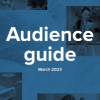How to use the Audience Spectrum Segments in your Catchment Area chart on your Overview Dashboard
Contents
Topics
Audience Spectrum is a segmentation tool which describes the whole UK population in terms of their cultural habits, preferences and general lifestyles. It gives you an understanding of who your current and potential audiences are; and suggests the tools and tactics you could use to engage more people, more effectively.
Understanding the chart
Comparing the Audience Spectrum profile of your audience to that of the wider population in your area can help you identify your best opportunities. Some ways it can be used are: audience development, marketing, fundraising and evaluation.
Perhaps just as importantly, it can also suggest where not to concentrate your precious time and resources.
In the chart on your Audience Answers Overview Dashboard, you’ll find each Audience Spectrum segment has two bars; one a solid colour, one shaded.
The solid colour bar represents your audience, with the segmentation being determined by the postcodes of your ticket bookers.
The red bars are segments considered generally higher engaged with arts and culture, yellow-green are medium, and blue/teal are lower engaged.
Meanwhile the shaded colour bar is the total population of your catchment area.
If the solid colour bar is longer than the shaded then you have a larger proportion of this segment in your audience, compared to the total population of your catchment area.
If a segment is strongly over-represented in your data then there is probably little room for growth. However, you don’t want to lose sight of this ‘core’ audience – they're your regular, dependable visitors who like what you’re doing and might be unsettled by any radical change in your offer.
However, if the shaded bar is longer, you have an under-representation of this segment among your audience, compared to the wider population.
If it’s a usually-highly-engaged segment (towards the top of the chart, in red or yellow-green), then your offer, for whatever reason, is not breaking through and reaching this group. A look at the pen portraits may give a clue as to why this might be: for example Experience Seekers may not see your organisation as providing the social experiences they crave. Or perhaps your communications tactics may need a tweak to speak your target segment’s language.
If the under-representation is evident for one or more of the blue/teal segments towards the lower half of the chart, then don’t be disheartened. This is normal and to be expected to some degree as after all, these segments are inherently more difficult to engage. If you’re seeing anything close to your audience in these segments being equal to your wider population (i.e. the bars the same length), then this is an achievement to be celebrated as your tactics to engage these groups are clearly working.
This information helps you decide on what action to take.
Identify your targets
The next step is figuring out which segments represent the best potential for your organisation.
You’re probably not going to have the resources to create tailored engagement plans for every segment, so narrowing it down to the top two or three will ensure your efforts are directed most effectively.
You’ll want to bear a couple of things in mind as you do this:
Your organisation’s business objectives
If your organisation’s top priority is boosting income, you may want to focus on those segments towards the top of the chart, (coloured red) who tend to be the most enthusiastic culture attenders, (even if these are already well-represented among your audiences). They’re likely to represent the best prospects for high-value ticket sales, loyalty and repeat attendance, and have the most potential to become donors.
On the other hand, if you want to reach those who are not traditionally highly engaged with arts and culture, your focus may be best applied towards the segments in the lower half of the chart (coloured blue/teal).
The makeup of your catchment area
There’s no point picking a segment to focus on if there isn’t a large population of this type to be found in your catchment area. For example, Metroculturals may seem an obvious target: they’re affluent, keen consumers of culture. However there simply aren’t very many of them outside London – so do check there’s actually a good-sized local population for you to work with.
Example organisations
Here are a few examples of how various organisations could put all of the above into practice:
A midscale regional theatre
Metroculturals (1.)
While they’re a very highly engaged segment, you have very few of them in your local population, so probably not worth spending much energy here.
Experience Seekers (2.)
This highly engaged segment could be relatively easy for you to attract with the right programming, and they’re currently under-represented among your audiences.
Frontline Families (3.)
You have lots of people from this segment in your area, but they’re not making up a correspondingly large proportion of your audience. If it’s important to your organisation to reflect your community, then this is a segment you may want to get to know.
A London art gallery
Metroculturals (1.)
Metroculturals dominate your visitors – how could you make the most of this? They’re an affluent segment, perhaps good potential donors?
Trips & Treats, Home & Heritage, Up Our Street (2.)
While these segments make up a small portion of your visitors, this is in proportion to your local population, so they’re probably less of a priority.
Kaleidoscope Creativity (3.)
You have a significant under-representation of this segment in your bookers compared to the local population, so definitely one to address if you want to better reflect your community in your visitors.
Next steps
Once you’ve identified your top segments to target, have a look at the relevant pen portraits for some ideas of the tactics you could consider to engage each of your top segments. Here you will find information like the recommended communication tone and channels to help formulate your strategy along with a wealth of other information about their preferences and behaviours. Additionally, consult the audience spectrum map to learn where your chosen segments live.
You can then track your progress by checking your Overview Dashboard regularly and seeing how your audience profile is changing.
Related Guides
- Boost Your Email Marketing with Audience Spectrum - a step by step guide
- How to use Audience Spectrum to Enhance your Funding Applications
- How to Use Audience Spectrum to Inform Your Programme and Engage with Diverse Audiences
- How to use Audience Spectrum to Target Paid Online Advertising
- Segmentation made simple
- Using Audience Spectrum Subsegments | Speak your benefactors' language
- Using Audience Spectrum Subsegments | Upsell your add-ons more effectively
- Top Tips | Using the Audience Spectrum Subsegments
- Using Audience Spectrum Subsegments | Get personal with your profiling
- Using Audience Spectrum Subsegments | Access your underserved audiences
- How understanding audience segmentation can inform your website user experience
- Explanation: Mosaic
- What is the Audience Spectrum Enhancement in Spektrix, and how does it work?
- How to get started with applying Audience Spectrum attributes to your Spektrix reports
- Using Audience Spectrum strategically as a customer attribute in Spektrix
- Creating and improving dynamic content in Spektrix using Audience Spectrum
Related Questions
- How do I get set up with the Audience Spectrum Enhancement for Spektrix?
- I have an Audience Spectrum license: why are some of my customer records profiled as ‘Unclassified’ & ‘Unmatched.’
Case Studies
-
 Audience Spectrum in Action | Securing Funding for a Circus Festival
Audience Spectrum in Action | Securing Funding for a Circus Festival
-
 Audience Spectrum in Action | Aberdeen Performing Arts
Audience Spectrum in Action | Aberdeen Performing Arts
-
 Audience Spectrum in Action | London & Culture Calling Arts
Audience Spectrum in Action | London & Culture Calling Arts
-
 Audience Spectrum in Action | Theatr Brycheiniog
Audience Spectrum in Action | Theatr Brycheiniog
-
 How Audience Spectrum helped support Nottingham Playhouse's Levelling Up Strategy
How Audience Spectrum helped support Nottingham Playhouse's Levelling Up Strategy
-
 Looking ahead at Hall for Cornwall
Looking ahead at Hall for Cornwall
-
 Using Audience Spectrum to drive culture change and a major audience development programme
Using Audience Spectrum to drive culture change and a major audience development programme
-
 Audience Spectrum in Action | Edinburgh International Festival
Audience Spectrum in Action | Edinburgh International Festival
-
 Shakespeare North Playhouse: Audience development using Audience Spectrum as a catalyst and tool
Shakespeare North Playhouse: Audience development using Audience Spectrum as a catalyst and tool
